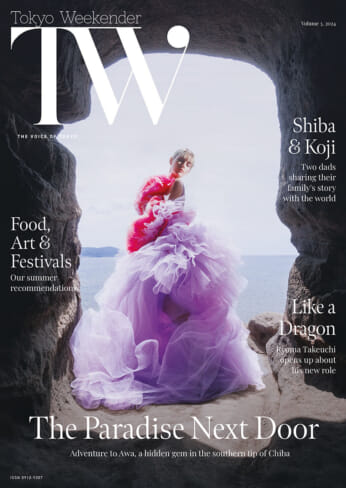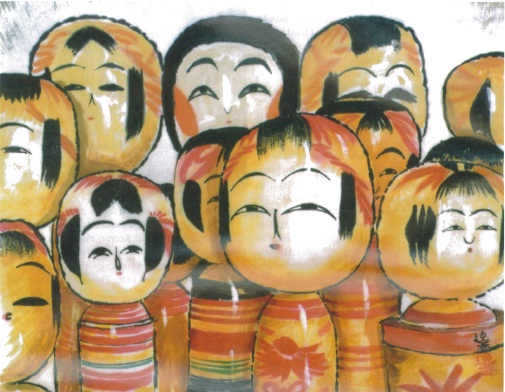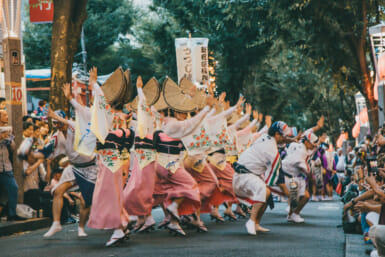Foreign women try their hand at Japanese arts
by Melissa Feineman
What do colorful paintings of children fishing, installations of giant pink cocoons strategically placed in trees in the springtime, and organizing overseas concert tours all have in common? While these may all sound like the works and experiences of contemporary artists and musicians, they have all been undertaken under the auspices of traditional Japanese arts.
Itske Stern began taking sumi-e classes when she moved to Japan eight years ago. Sumi-e is a style of Japanese brush painting that makes use of black ink and color. If, when you hear ‘Japanese brush painting’, you imagine simple brush strokes that evoke bamboo or cherry blossoms, think again. While sumi-e can certainly involve those traditional images associated with Japan, the possibilities for subject matter and color palette are limitless. Itske’s prize-winning paintings depict colorful pink and green garden scenes, bright blue and yellow-clad children fishing in a pond, and orange and red kokeshi or traditional Japanese dolls, Itske’s other passion. She explains that she draws her inspiration from “anything and everything. My camera is my sketchpad. Everywhere I look I see a picture, and if I see something that really inspires me, I paint it.”
The people here are so helpful. If they see
that you want to learn a little bit, they’ll
teach you everything you want to know and more
Kathleen Adair’s work is equally surprising if you have come to think of ikebana as a collection of flowers artfully arranged in a vase and displayed in the comer of a traditional Japanese home. Ikebana, as Kathleen explains it, traditionally involves the artful arrangement of plant materials in the tokonoma (an alcove in the tea room that is usually decorated in a traditional Japanese style that changes according to the season). However, it has evolved to include urban exhibitions and outdoor installations as well as the use of nonorganic materials. Kathleen, a Master Teacher of the Ichiyo School of Ikebana, has created numerous ikebana exhibits that involved neither flowers nor vases. She spun giant cocoons out of unraveled hemp rope which she dyed pink, and later used the same hemp fiber to create a flowing stream in a dry riverbed. For another project, she used the same pink fiber, winding it into tall bamboo shoots that towered over her small frame. A background in art attracted her to ikebana initially, but Kathleen admits that it is the complexity and sophistication of ikebana that has maintained her interest for all this time. “The more you participate and train, the more satisfying it is. You can raise your skills to deepen your personal expression profoundly.” Plus, she adds, “Ikebana people tend to be happy, open, and excited.”
Stephanie Tomiyasu, a research psychologist by trade, echoed Kathleen’s praise for ikebana people. It was through her local chapter of Ikebana International that she became involved in shinnai, a form of narrative singing accompanied by shamisen after she heard her shishou, or teacher, Tsuruga Wakasanojo XI, iemoto of the Tsuruga School of Shinnai, perform at her Ikebana International chapter meeting. “I thought it was the most beautiful music I’d ever heard,” she explains. She approached the shishou, and he agreed to take her on as a student, trusting his instinct about her. The arrangement has proved to be mutually beneficial, since Stephanie volunteered to organize several performance tours to the U.S., enabling shinnai — an art form that even most Japanese do not know about — to reach an international audience.
Itske, Kathleen, and Stephanie were all overwhelmingly positive when describing their experiences as foreign women participating in traditional Japanese arts. According to Itske, “the people here are so helpful. If they see that you want to learn a little bit, they’ll teach you everything you want to know and more. As a foreigner, I’ve found that if you live in a country, whether it’s your own or somebody else’s, you have to give something back, and be interested in the culture.” Stephanie added that, as the first and only foreigner to perform shinnai joruri (narrative song), she has received a lot of extra attention, especially from the Japanese media. Plus, the friends that she has made, both through shinnai and Ikebana International, have become her closest and dearest companions in Japan.
While you may think that you need to have both a high level of Japanese and an artistic background in order to become involved in Japanese arts, these are not necessarily prerequisites. While conversational Japanese will allow you to connect with your classmates more easily, it is not essential for understanding the art itself. Itske explains, “Like music, art has no need for language.” Kathleen said that her art background was helpful in the way that she had already developed an understanding of color and texture combinations, but she believes anyone can learn ikebana. And Stephanie adds that, more than any inherent skill “you have to be willing to work hard and practice a lot, but if you love the thing you’re doing, all of that will come naturally anyway.”
If you’re interested in getting involved in traditional Japanese arts, a great place to start is the Tokyo Union Church’s Women’s Society. They offer short-term classes in English on a variety of subjects.
5-7-7 Jingumae, Shibuya-ku, Tokyo
Tel. 03-3400-0047,
Fax: 03-3400-0942
Monday to Friday, 10am-2pm
Email: [email protected]
www2.gol.com/users/tuc/ws/contactus.html
If you’d like to learn more about ikebana, Kathleen recommends two avenues. The first is getting in touch with your local chapter of Ikebana International.
Misaki Building 5th Floor, 3-28-9, Kanda Ogawamachi,
Chiyoda-ku, Tokyo 101-0052
Tel.03-3293-8188,
Fax: 03-3294-2272
Email: [email protected]
www.ikebanahq.org
Please note that Ikebana International does not actually offer classes, but they can put you in touch with schools and teachers, and also offer a great network of friends who share an interest in Japanese culture. The second option is to make note of the school that interests you when you see an exhibition. There are over 2,000 schools of ikebana and each has its own technique and style, so you should choose one that appeals to your sensibilities. If you see an arrangement you like, be sure to ask at the information desk of the exhibit for the name of the school and/or teacher.
For people who are interested in participating or learning more about shinnai, please contact Wakasa-nojo Shishou. His phone number is 03-3260-1804 and his email address is [email protected]. It is also possible to take lessons with his assistant, Tsuruga Isejirou-san. Emails can be addressed to her at Wakasanojo’s email address, or she can also be contacted on 090-5390-2447.
For those who would like to study sumi-e, please contact Tori Hashizume. She gives lessons in the Hanamo Building in Omotesando on Mondays and at the Tokyo Union Church on Tuesdays. She can be contacted by telephone or fax on 04-8461-3992 or through the Tokyo Union Church.
Finally, be sure to contact your local ward office to find out about a range of Japanese art classes, usually offered in English.









